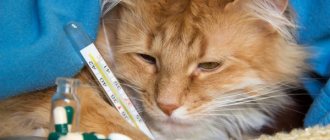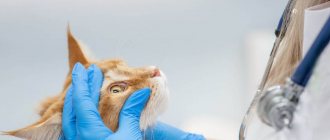What will you learn from the article?
- What is mycoplasmosis in cats? Forms of the disease
- What causes the disease
- How do mycoplasmas work?
- Risk group
- General symptoms of mycoplasmosis in cats
Mycoplasmosis in cats or feline infectious anemia is a disease caused by mycoplasma parasites (Mycoplasma haemofelis). These protozoan organisms parasitize erythrocytes - red blood cells. The more blood cells are infected with parasites, the worse the pet's condition becomes.
Is the disease dangerous, how is it treated, how can you protect your pet from it? Let's try to find answers to all questions in this article.
Description of mycoplasmosis
Mycoplasmosis most often affects the body of a weakened animal.
The causative agents of mycoplasmosis in cats belong to the category of facultative aerobic parasites, occupying an intermediate position between fungi, bacteria and viruses.
Their main feature is that they have the ability to change their shape, since they do not have cell walls, which significantly complicates the process of diagnosing the disease.
M. gatae and M. felis are capable of surviving outside a living organism for some time.
However, when unfavorable conditions arise (low temperatures, high levels of UV, exposure to chlorine-containing agents, etc.) they quickly die.
But despite this, they show high resistance to some antibacterial drugs. They mainly live on ground surfaces, plants, household items and in water.
They have several transmission routes:
- airborne;
- contact (during games, fights, etc.);
- sexual;
- during pregnancy and labor (from an infected cat to offspring);
- during blood transfusion.
Penetrating into the animal's body, mycoplasmas begin to actively secrete endotoxins, which provoke the activation of destructive and degenerative processes in tissues, which subsequently leads to their destruction and disruption of their functionality.
How can your pets become infected?
In several ways:
- from a sick animal or from a carrier of infection;
- through toys, combs, food bowls, bedding for a sick purr;
- during mating;
- through mosquito bites;
- through fleas, ticks, lice eaters;
- from the mother at birth and breastfeeding;
Symptoms of mycoplasmosis in cats
Only an experienced veterinarian can find out exactly what mycoplasmosis is.
Mycoplasmosis in cats does not have pronounced symptoms.
It manifests itself with various clinical signs that are vague in nature, for example:
- loss of appetite and weight loss;
- inflammation of the conjunctiva;
- decreased physical activity;
- pale gums;
- mucous discharge from the eyes;
- increased salivation.
Important! If at this stage mycoplasmosis is diagnosed in a cat, the symptoms are stopped and treatment is completed, then there is a high chance of defeating the disease and maintaining the health of the pet.
When the disease is not recognized at this stage, the clinical picture becomes more complex over time.
Symptoms become severe and include the following signs:
- hair loss;
- urinary disturbance;
- digestive disorders (vomiting, nausea, constipation, diarrhea);
- purulent discharge from the eyes.
Be sure to read:
What is dangerous about toxoplasmosis, symptoms and treatment of the disease in cats and people
The pet begins to suffer from painful sensations in the ribs; he almost constantly lies down and rarely gets up.
Purulent discharge from the nose and eyes is a characteristic sign of mycoplasmosis.
When the articular elements are affected, there is a disturbance in the animal’s motor functions, which is clearly visible in its gait - the cat limps, draws in its paws, and cannot remain in a standing position for a long time.
Since feline mycoplasmosis affects various internal organs and systems of the pet, the symptoms include different symptoms , which is why the disease can easily be confused with another disease, for example, a cold.
Asymptomatic mycoplasmosis in cats
Asymptomatic mycoplasmosis in cats is rarely observed. The only sign that determines the presence of the disease is a change in the pet’s behavior.
He becomes lethargic and sleeps a lot. This is how a sharp decrease in immunity occurs due to the impact of infection on the body.
What causes danger
- Toxicity
The waste products of mycoplasmas are dangerous due to their toxicity and destructive effect on the cells of the body. Because of this, the normal functioning of all important organs becomes impossible: eyes, gastrointestinal tract, respiratory organs and genitourinary system.
- Provoking infections
A healthy human or animal body always (!) contains within itself various pathogenic bacteria in a “dormant state,” and mycoplasmas have the ability to “awaken” them to active life, thereby provoking various infectious diseases. And the weaker the immune system, the greater the chances of getting sick.
Mycoplasmas are provocateurs!
Causes of mycoplasmosis, risk group
At risk of contracting mycoplasmosis are:
- kittens under 2 years of age;
- animals with reduced immunity;
- cats with chronic pathologies.
Since the causative agent of this disease cannot exist for a long time outside a living organism, it is almost impossible to become infected with it while drinking water or eating food.
Therefore, it is believed that the only way of transmitting the infection is direct contact with an infected animal.
Penetration of microorganisms into the body of a healthy cat can occur through blood transfusion, contact with open wounds or cuts, during sexual intercourse, or during delivery (from mother to kitten).
Is it contagious?
...for a person?
There is only one answer to this question: feline mycoplasmosis is not transmitted to humans.
Research by various scientists has proven the existence of about 100 species of mycoplasmas. Of these, only 6 are dangerous to humans. They are transmitted from an infected person to a healthy person through sexual contact. And the child becomes infected from the mother in utero or at birth.
…for cats?
Feline mycoplasmas are harmless to the strong immunity of healthy animals. It protects them from infection!
Is it dangerous for pets who are weakened, pregnant, young or over 8 years old?
Answer: dangerous and contagious!
Infected and sick animals are a source of infection for this risk group.
…for dogs?
Dogs and cats have different types of mycoplasma that causes the disease. Therefore, the possibility of them becoming infected from each other is unlikely.
Diagnosis and treatment
If an animal has signs of mycoplasmosis, it must be taken to a veterinarian immediately. After reviewing the history, the doctor will perform a physical examination of the cat and order a complete blood test.
Pneumonia is a common complication after mycoplasmosis.
If an infection actually develops in the pet’s body, laboratory tests reveal anemia - a low level of red blood cells.
Along with this analysis, it is also recommended to do:
- screening;
- flow cytometry analysis (considered the most informative method for diagnosing mycoplasmosis);
- analysis of the genital mucosa;
- smear of the eye shell.
If the diagnosis is confirmed during the diagnosis, treatment of mycoplasmosis in cats is carried out immediately. There is no specific treatment regimen for this disease. It all depends on the severity of clinical manifestations and the general condition of the animal.
Antibacterial therapy is prescribed in any case. It suppresses bacterial growth and improves the pet’s well-being.
The choice of antibiotics is made individually after a special susceptibility test. If the pet is found to have severe anemia, a blood transfusion is performed.
Be sure to read:
What is dangerous about toxoplasmosis, symptoms and treatment of the disease in cats and people
In addition to antibacterial therapy, symptomatic treatment is also carried out, which includes taking astringent, analgesic and antiemetic drugs.
Quite often, the only sign of mycoplasmosis in cats is weakness of the animal.
Also during this period it will be useful for the animal to take medications and dietary supplements that help improve the functioning of the digestive system.
To speed up the recovery process and prevent the development of complications due to mycoplasmosis, it is recommended to give the animal immunomodulatory drugs.
Important! If mycoplasmosis in cats manifests itself with severe symptoms, then treatment is carried out in a hospital.
Only after the pet’s condition returns to normal is it given back to its owners, but the therapy does not end there. At home, you will also need to ensure that the animal takes all necessary medications, proper nutrition and rest.
Medicines
All medications for the treatment of mycoplasma in an animal, their dosage regimen, dosage and duration are determined by the doctor individually. However, there are some medications that are used in almost 90% of cases.
Doxycycline and chloramphenicol are broad-spectrum antibiotics that are highly effective in combating pathogens of mycoplasmosis.
Veterinarians prescribe azithromycin to support pet immunity
Positive results from taking them are observed already on the second day. If an animal shows intolerance to these drugs, then they are replaced with Tylosin or Baytril.
For this disease, the following are also often prescribed:
- Karsil, Katozal or Gamavit - these products stimulate the functioning of internal organs.
- Cycloferon, Immunofan or Ribotan - the action of these drugs is aimed at strengthening the immune system.
- Tetracycline has an antibacterial effect and is used to treat affected mucous membranes of the eyes and genitals.
Caring for a cat when sick
To prevent the development of complications due to mycoplasmosis in a cat and treatment to produce quick results, the animal must be provided with proper care.
All medications for the treatment of mycoplasma in an animal, their dosage regimen, dosage and duration are determined individually by the doctor.
If there are no other pets in the apartment, there is no need to isolate him. It’s enough just to create a comfortable and convenient lounger for him.
To avoid causing unnecessary suffering to the cat, you should not pick it up. This is due to the fact that with the development of mycoplasmosis, all joint and bone tissues of the animal are affected, and any movements can cause severe pain.
Important! Bathing, combing and walking your pet during the treatment period is prohibited.
Diet for the duration of treatment
At the time of treatment, the cat's diet should be adjusted. If she is fed at home, you need to make sure that the food she eats is fresh and prepared from high-quality products.
Be sure to read:
What is dangerous about toxoplasmosis, symptoms and treatment of the disease in cats and people
It is important to provide the animal with plenty of fluids, vitamins and minerals. To replenish the latter, you can use special vitamin complexes for pets. When choosing them, you must take into account the age and weight of the cat.
Maintenance and care
Treatment of mycoplasmosis primarily involves antibiotic therapy. Treatment at home usually takes quite a long time. The duration of antibiotic treatment is determined based on symptoms, usually the course duration is at least 3 weeks. The selection of an antibiotic and calculation of the required dose is always made by the doctor, based on the cat’s medical history, its condition, the severity of the disease and concomitant pathologies. Sometimes additional symptomatic treatment may be required. It is important to regularly use any antibiotic therapy throughout the entire period of treatment, otherwise relapses of the disease and a decrease or absence of the effect of therapy are possible.
Cats with a healthy immune system who receive proper antibiotic treatment have a favorable prognosis for treatment and cope with the disease fairly quickly.
Prevention methods
There are no vaccinations against mycoplasmosis. However, this does not mean that it is impossible to prevent the development of this disease in a pet.
To prevent mycoplasmosis, veterinarians recommend vaccinating the animal against other diseases according to the plan and paying sufficient attention to its immunity, providing it with all the necessary minerals and vitamins.
Although such measures will not protect the cat from this disease, they will significantly reduce the risk of infection from other pets.
How is it diagnosed?
Medical suspicions regarding the pet's diagnosis can be confirmed by a biochemical blood test.
It is difficult to establish an accurate diagnosis for this disease, just like hemoplasmosis, mycoplasmosis can be detected if you take a blood test from your pet, which will show anemia and leukocytosis, as well as a urine sample, which will reveal proteinuria. To clarify the diagnosis, biochemistry is prescribed, which, as the disease progresses, will show a deficiency of albumin and globulin. Based on the diagnostic results, the veterinarian draws up an individual treatment plan.
Does a sick cat pose a danger to humans?
It is difficult to say whether mycoplasmosis in cats poses a danger to humans. There are two opinions on this matter. Some argue that the pathogens that cause disease in animals are not dangerous to humans.
Others say that when exposed to certain factors, contact with a sick cat can lead to serious consequences.
Particularly at risk are people with reduced immunity, those suffering from viral and infectious diseases, as well as children aged 0 to 3 years.
For women
In women, mycoplasmosis can lead to:
- menstrual irregularities;
- exacerbation of chronic pathologies of the reproductive organs;
- visual impairment;
- joint diseases;
- disruption of the liver and kidneys.
For men
For men with weakened immune systems, mycoplasmosis is dangerous:
- violation of potency;
- development of diseases of the genitourinary system;
- infertility.
Why do you need a veterinarian diagnosis?
After detecting alarming symptoms, your mustachioed pet must be taken to a veterinary clinic. Due to the similarity with colds and other pathologies, independent diagnosis is impossible. At best, attempts at home treatment simply will not yield results; at worst, they will aggravate the patient’s condition.
Diagnosis by a veterinarian involves the following studies:
- analysis of the clinical and biochemical composition of the blood (in the presence of infection, the number of red blood cells is below normal);
- ELISA and PCR, determining the type of pathogen;
- taking smears from the genitals and conjunctiva;
- bacteriological analysis of urine, determining the sensitivity of bacteria to antibiotics.
After confirmation of mycoplasmosis in a cat, the veterinarian selects a treatment regimen. On average, recovery takes 2-3 weeks.











